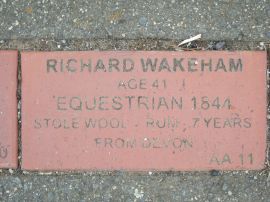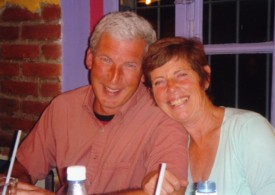February 2016 Round the World in 27 Days – Chapter 3.
We left Christchurch to head to Launceston in Tasmania via Melbourne. We had quite a wait in Melbourne for our connection which had been made longer because Gerry had failed to take the time difference between Melbourne and Christchurch into account! However, we picked up the rental car at Launceston airport and made the short journey to our motel on the outskirts of the town in time to enjoy a glass of Tasmanian wine before retiring. The next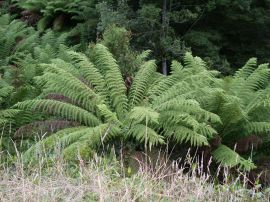 day we headed for the coastal town of Swansea but decided to travel on the northern route over the mountains and through the rainforest. We were not disappointed, the scenery was beautiful. We were heading through the Weldborough Pass when we saw a sign telling us that there was a walk that we could take through the rainforest. The walk was not very long and in the absence of any other people and no sounds other than the birds and the wind in the trees it was magical.
day we headed for the coastal town of Swansea but decided to travel on the northern route over the mountains and through the rainforest. We were not disappointed, the scenery was beautiful. We were heading through the Weldborough Pass when we saw a sign telling us that there was a walk that we could take through the rainforest. The walk was not very long and in the absence of any other people and no sounds other than the birds and the wind in the trees it was magical.
We continued on our journey and stopped at the lovely town of Scottsdale for coffee marvelling at the width of the streets. Next we headed to the hamlet of Pyengana and 9 km down a no through road to the St Columba Falls. 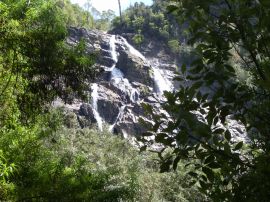 The falls were reached along a 600m path that descended into the valley where we could gaze up at one of the tallest waterfalls in Tasmania. Despite the isolated location, the absence of any shops/cafes, and the lack of vehicles on the roads, we were surprised by the number of people at the Falls.
The falls were reached along a 600m path that descended into the valley where we could gaze up at one of the tallest waterfalls in Tasmania. Despite the isolated location, the absence of any shops/cafes, and the lack of vehicles on the roads, we were surprised by the number of people at the Falls.
Returning to the main road, we continued our journey to Swansea stopping in the only other major town on the route, St Helens, where we managed to get a late lunch. We eventually arrived at Swansea in time to go for a short walk and find a delightful restaurant overlooking the sea. We sat on the balcony for wine and nibbles before going inside to eat our meal.

 The food was delightful and Gerry had his first curried scallop pie of the trip. Tasmania is famous for its scallop pies and the curried ones in particular. The taste was amazing and just as good as he remembered from our last visit to Tasmania in 2008 (Gerry was to have several more such pies before we left the island!)
The food was delightful and Gerry had his first curried scallop pie of the trip. Tasmania is famous for its scallop pies and the curried ones in particular. The taste was amazing and just as good as he remembered from our last visit to Tasmania in 2008 (Gerry was to have several more such pies before we left the island!)
The next morning we headed for the town of Richmond and found ourselves surrounded by tourists. That’s an exaggeration it just seemed like a lot of people compared with everywhere else we had been in Tasmania. The town itself is old and has many historic buildings as well as a 19th century bridge built by the convicts who had been transported to Tasmania from the UK, The quality of construction was really good and, like many bridges in the south eastern part of Tasmania, has stood the test of time and greatly increased usage without any major repairs. 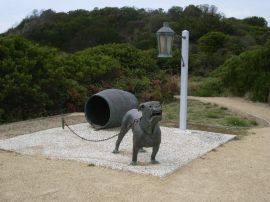 We then visited Eaglehawk Neck which is a narrow isthmus that connects the Tasman Peninsula to the main part of Tasmania. A line of dogs were chained at strategic intervals to prevent convicts escaping from the convict settlement at Port Arthur to cross the isthmus. The statue of the dog certainly portrays their fierceness.
We then visited Eaglehawk Neck which is a narrow isthmus that connects the Tasman Peninsula to the main part of Tasmania. A line of dogs were chained at strategic intervals to prevent convicts escaping from the convict settlement at Port Arthur to cross the isthmus. The statue of the dog certainly portrays their fierceness.
We decided not to go all the way to Port Arthur has we had spent a day there on our last visit. Instead we headed to the central highlands of Tasmania and the historic town of Bothwell where we had booked bed and breakfast at the 19th century Bothwell Grange.The Grange was not that big and despite its history as a drinking, eating and resting place was now rather sad. The town of Bothwell was very spacious and pretty but quiet.  There was nowhere we could get a meal that evening unless we ate a fried takeaway before 5PM. We even drove 32km each way to the equally quiet town of Hamilton and found a similar lack of eating places. However, back in Bothwell we found a shop and bought some fruit, cheese and crackers and then bought a bottle of wine from the pub. We enjoyed our repast sitting on the balcony of Bothwell Grange.
There was nowhere we could get a meal that evening unless we ate a fried takeaway before 5PM. We even drove 32km each way to the equally quiet town of Hamilton and found a similar lack of eating places. However, back in Bothwell we found a shop and bought some fruit, cheese and crackers and then bought a bottle of wine from the pub. We enjoyed our repast sitting on the balcony of Bothwell Grange.
We returned to Launceston the following day travelling to the east coast through Campbell Town and then back through the hills and rainforest. The bridge at Campbell Town is just like the one at Richmond but the difference is that it was easier to understand the scale of the penal colonies and the harshness of the regimes because, set in the pavement of the main road, there were hundreds of bricks each one inscribed with details of a convict who had worked on the Campbell Town Bridge. When you looked at the offences and the punishments awarded, wrongdoers today just don’t know how lucky they are.
Since our visit in 2005 a collection of elaborate wooden carved statues has appeared. I suspect they are not to everybody’s taste but they certainly depicted a little of the history of the area.
Our second visit to Tasmania had been every bit as good as the first! and it was with some sadness that we returned to the airport the next morning to begin the next leg of our trip.




